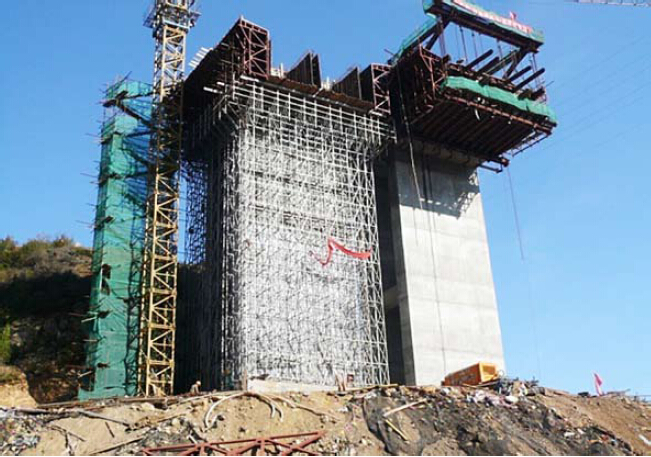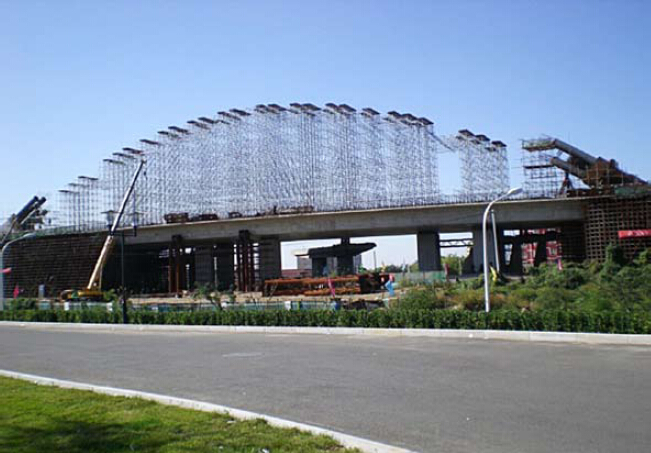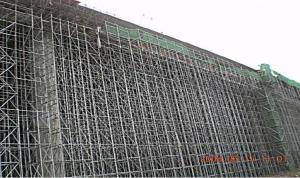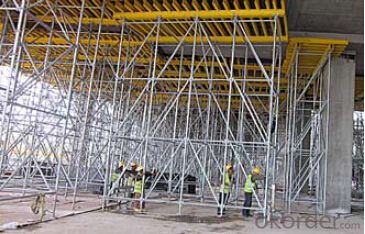Tower scaffolding for formwork and scaffolding systems
- Loading Port:
- Tianjin
- Payment Terms:
- TT OR LC
- Min Order Qty:
- 50 m²
- Supply Capability:
- 1000 m²/month
OKorder Service Pledge
Quality Product, Order Online Tracking, Timely Delivery
OKorder Financial Service
Credit Rating, Credit Services, Credit Purchasing
You Might Also Like
Tower Scaffolding
Shoring tower is an effective supporting system. It is easy to assemble and dismantlement, and
has excellent stability and bearing capacity. It has been widely used in the construction of industry
& residential buildings , bridges, tunnels and dam project, etc.
Characteristics:
◆ High degree of standardization.
◆ Easy storage and transportation


- Q: Can steel formwork be used for both horizontal and vertical construction elements?
- Yes, steel formwork can be used for both horizontal and vertical construction elements. Steel formwork is a versatile and durable option for creating concrete structures. It can be easily adjusted and assembled to accommodate various shapes and sizes, making it suitable for both horizontal elements like slabs and beams, as well as vertical elements like walls and columns. Steel formwork provides excellent support and stability during the concrete pouring process, ensuring the desired shape and finish of the construction elements. Additionally, steel formwork can be reused multiple times, making it a cost-effective choice for construction projects.
- Q: How does steel formwork contribute to the overall cost of concrete construction?
- There are several ways in which steel formwork affects the overall cost of concrete construction. Firstly, the upfront cost of steel formwork may be higher compared to timber or plastic. However, the long-term durability and reusability of steel formwork can offset this initial expense over the lifespan of multiple construction projects. In addition, the use of steel formwork can significantly reduce the time needed for formwork assembly and dismantling. This leads to increased efficiency and productivity on the construction site, resulting in potential savings in terms of labor and project duration. Furthermore, steel formwork's superior strength and stability allow for the construction of larger and more complex structures. This can eliminate the need for additional support structures or reinforcements, ultimately reducing construction costs. Moreover, steel formwork provides a smooth and high-quality finish to the concrete structure, eliminating the need for additional plastering or finishing work. This not only saves on material costs but also reduces the overall construction time. Lastly, the reusability of steel formwork allows for multiple applications on different projects, providing long-term cost benefits. Unlike other formwork materials that may require frequent replacement, steel formwork can be used for multiple construction cycles, reducing the need for new formwork materials and saving costs in the long run. In conclusion, despite the higher initial investment, the durability, efficiency, superior strength, and reusability of steel formwork contribute to cost savings in terms of labor, project duration, material usage, and long-term formwork expenses.
- Q: Plastic building templates where there is an urgent need to solve
- Three, release simple. The concrete does not touch the surface, without the release agent, easy demoulding, easy to clear ash.Four, stable weather. The mechanical strength is high, under the condition of the temperature of -20 DEG C to +60 DEG C, the utility model has the advantages of no shrinkage, no expansion, no cracking, no deformation, stable size, alkali resistance, corrosion resistance, fire resistance, water resistance and insect repellent
- Q: How does steel formwork prevent concrete shrinkage and cracking?
- Steel formwork helps prevent concrete shrinkage and cracking by providing strong and rigid support during the curing process. When concrete is poured into the steel formwork, it takes the shape of the structure being built and hardens over time. The steel formwork acts as a mold, holding the concrete in place and preventing it from shrinking or cracking as it dries. One of the main causes of concrete shrinkage and cracking is the loss of moisture during the curing process. As the water in the concrete evaporates, it causes the material to shrink. This shrinkage can lead to cracks forming in the concrete if it is not properly supported. Steel formwork helps prevent this shrinkage by providing a tight and secure enclosure for the concrete. It ensures that the concrete retains its moisture and does not dry out too quickly. This slow and controlled drying process allows the concrete to cure evenly and reduces the likelihood of shrinkage and cracking. Additionally, steel formwork provides stability and support to the concrete, preventing it from moving or shifting as it hardens. This stability helps to distribute the forces and stresses evenly, reducing the risk of cracking or structural failure. Furthermore, the smooth and rigid surface of steel formwork helps to achieve a high-quality finish on the concrete. This prevents any irregularities or imperfections that may weaken the structure or make it more susceptible to cracking. In summary, steel formwork plays a crucial role in preventing concrete shrinkage and cracking by providing support, stability, and moisture retention during the curing process. Its strong and rigid structure ensures that the concrete remains intact and achieves a high-quality finish, reducing the risk of structural issues and enhancing the durability of the construction.
- Q: How does steel formwork handle different concrete admixtures?
- Steel formwork, with its versatility and durability, is capable of managing different concrete admixtures. These admixtures, which improve the properties of concrete, include strength, workability, durability, and setting time. An advantage of steel formwork is its resistance to chemical reactions caused by concrete admixtures. Steel is highly resistant to corrosion and can withstand the alkaline environment of concrete and potential chemical reactions caused by admixtures. Steel formwork effectively handles various admixtures like accelerators, retarders, plasticizers, and air-entraining agents. Accelerators speed up the concrete setting and hardening process, while retarders slow down the setting time. Steel formwork accommodates the different setting times caused by these admixtures, allowing for efficient construction. Plasticizers, also known as water-reducers, are commonly used to improve concrete workability and flow. Steel formwork easily handles the increased fluidity of concrete with plasticizers, ensuring it maintains its shape and does not leak or slump excessively. Air-entraining agents introduce microscopic air bubbles into concrete, enhancing its durability and freeze-thaw resistance. Steel formwork handles the entrapped air, maintaining the required consistency and structural integrity of the concrete. Moreover, steel formwork can also manage specialized admixtures like corrosion inhibitors, shrinkage reducers, and waterproofing agents. These admixtures address specific challenges in concrete construction, and steel formwork provides a reliable and stable platform for their successful implementation. In conclusion, steel formwork is a strong and adaptable system that effectively handles various concrete admixtures. Its corrosion resistance and stability make it an ideal choice for accommodating the chemical reactions and properties of different admixtures, resulting in high-quality and durable concrete structures.
- Q: What are the common safety guidelines when working with steel formwork in confined spaces?
- To ensure the well-being of workers involved in working with steel formwork in confined spaces, it is crucial to adhere to specific safety guidelines. Consider the following commonly recommended safety measures: 1. Thoroughly assess risks: Prior to commencing work in a confined space, it is imperative to evaluate potential hazards and risks associated with the task at hand. This evaluation should encompass the identification of dangers such as inadequate ventilation, limited access, or the presence of hazardous gases. 2. Ensure sufficient ventilation: Confined spaces often lack proper air circulation, which can result in the accumulation of toxic gases or oxygen deficiency. Before entering, verify that the area is adequately ventilated, and continuously monitor air quality throughout the task. 3. Utilize suitable personal protective equipment (PPE): Workers must always wear the appropriate PPE, which includes safety helmets, goggles, gloves, and respiratory protection as required. The specific PPE necessities may vary depending on the nature of the confined space and associated hazards. 4. Implement adequate lighting: Insufficient lighting in confined spaces can hinder visibility and compromise safety. To mitigate accidents, provide sufficient lighting to ensure clear visibility. 5. Establish proper entry and exit procedures: Clearly define entry and exit procedures for workers entering and exiting confined spaces. This should involve the use of appropriate signage, secure barriers, and the assignment of a responsible individual to monitor and control access. 6. Ensure effective communication: Establish a reliable communication system between workers inside and outside the confined space. This can be achieved through the use of two-way radios, hand signals, or other means of communication to prevent isolation and enable prompt assistance if necessary. 7. Regularly inspect equipment and formwork: Prior to commencing work, inspect the steel formwork and associated equipment for any damage or defects. Promptly address any issues to prevent accidents or structural failures. 8. Provide comprehensive training: Workers involved in working with steel formwork in confined spaces should receive thorough training on safety procedures, hazard recognition, emergency response, and proper equipment usage. Regular training updates should also be conducted to ensure workers remain knowledgeable about safety practices. 9. Establish an emergency response plan: Despite taking necessary precautions, emergencies can still occur. Develop an emergency response plan that outlines evacuation, rescue, and medical assistance procedures. Ensure all workers are familiar with the plan and conduct regular drills to practice these protocols. 10. Regularly review and update safety procedures: Continuously review and update safety procedures to incorporate new regulations, industry best practices, or lessons learned from previous incidents. Continuous improvement and monitoring of safety measures are vital to maintaining a safe working environment. Remember, working in confined spaces with steel formwork carries significant risks. By following these common safety guidelines and fostering a safety-conscious culture, the risk of accidents and injuries can be minimized, ensuring a safer working environment for all.
- Q: What is the lifespan of steel formwork?
- The lifespan of steel formwork can vary depending on various factors such as the quality of the steel used, the conditions it is exposed to, and the maintenance practices employed. Generally, steel formwork is known for its durability and longevity. With proper care and maintenance, it can last for several years and even decades. The high strength and resistance to wear and tear make steel formwork suitable for repeated use in construction projects. However, the lifespan of steel formwork can be affected by factors such as exposure to harsh weather conditions, improper handling, and inadequate maintenance. Corrosion can also be a concern, especially if the steel is exposed to moisture or chemicals without proper protection. To maximize the lifespan of steel formwork, it is important to use high-quality steel that is resistant to corrosion. Regular inspections should be conducted to identify any signs of damage or deterioration, and prompt repairs or replacements should be carried out. Proper cleaning, storage, and handling practices should also be followed to prevent unnecessary wear and tear. In conclusion, while the lifespan of steel formwork can vary, it can be expected to last for several years and even decades if high-quality steel is used, proper maintenance is carried out, and it is protected from corrosion and damage.
- Q: What are the different types of steel formwork corner solutions?
- There are several different types of steel formwork corner solutions available, including internal corners, external corners, and adjustable corners. Internal corners are used to create sharp angles within the formwork system, while external corners are used to form external edges and corners. Adjustable corners provide flexibility and can be adjusted to different angles as needed.
- Q: How does steel formwork contribute to the overall safety of the construction process?
- Steel formwork contributes to the overall safety of the construction process by providing a sturdy and stable structure for concrete pouring. Its strength and durability minimize the risk of accidents caused by collapsing or shifting formwork. Additionally, steel formwork is fire-resistant, reducing the likelihood of fire hazards on the construction site. Its reusable nature also reduces waste and potential environmental hazards, ensuring a safer working environment for construction workers.
- Q: How does steel formwork affect the overall waterproofing of a building?
- The main purpose of steel formwork is to provide stability and shape to wet concrete during the construction process. It does not directly affect the overall waterproofing of a building. Waterproofing is typically achieved through the use of waterproof membranes, sealants, or coatings applied to the external surfaces of the structure. Proper installation and sealing of the formwork joints are important to prevent water leakage during the concrete pouring process. Any gaps or cracks in the formwork can allow water to seep into the structure, potentially compromising the waterproofing system. Additionally, the choice of formwork material indirectly influences the overall waterproofing of a building. Steel formwork, being durable and robust, can withstand the pressure of wet concrete without deforming or leaking. This ensures that the concrete is shaped and compacted correctly, resulting in a more solid and stable structure. A well-constructed concrete framework indirectly contributes to the building's waterproofing capabilities by enhancing its integrity and longevity. In conclusion, while steel formwork does not directly impact the overall waterproofing of a building, it is crucial for maintaining the structural integrity of the concrete during construction. Proper installation and sealing of formwork joints are necessary to prevent water leakage. Ultimately, the choice and correct application of appropriate waterproofing materials determine the building's overall waterproofing performance.
Send your message to us
Tower scaffolding for formwork and scaffolding systems
- Loading Port:
- Tianjin
- Payment Terms:
- TT OR LC
- Min Order Qty:
- 50 m²
- Supply Capability:
- 1000 m²/month
OKorder Service Pledge
Quality Product, Order Online Tracking, Timely Delivery
OKorder Financial Service
Credit Rating, Credit Services, Credit Purchasing
Similar products
Hot products
Hot Searches
Related keywords

















